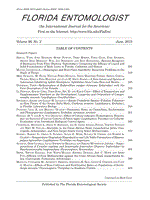The expansion of oil palm (Elaeis guineensis) monoculture may favor insect pests such as the caterpillars of Opsiphanes invirae Hübner, Brassolis sophorae L. (Lepidoptera: Nymphalidae) and Eupalamides cyparissias (Fabricius) (Lepidoptera: Castniidae). The objective of this study was to evaluate the potential of Trichospilus diatraeae Cherian & Margabandhu (Hymenoptera: Eulophidae) to parasitize pupae of lepidopteran pests of oil palm. Groups of fifty females of T. diatraeae were maintained inside test tubes with one pupa of one of the following hosts: O. invirae, B. sophorae or E. cyparissias for 48 h. Trichospilus diatraeae parasitized the 3 Lepidopteran species, but reproduced only on O. invirae and B. sophorae. These results suggest that this parasitoid, of polyphagous habit, may represent an alternative for the control of lepidopteran pests of oil palm in the Brazilian Amazon.
Oil palm (Elaeis guineensis) monoculture may favor insect pests and disease vectors (Gitau et al. 2009). The defoliating caterpillars, Opsiphanes invirae Hübner and Brassolis sophorae L. (Lepidoptera: Nymphalidae), and the crown-leaf borer, Eupalamides cyparissias (Fabricius) (Lepidoptera: Castniidae), affect the development and productivity of this crop in northern Brazil (Vasquez et al. 2008; Ribeiro et al. 2010). Studies involving control methods of these pests are needed.
Trichospilus diatraeae Margabandhu & Cherian (Hymenoptera: Eulophidae) is a pupal parasitoid of many lepidopteran families, such as Arctiidae (Bennett et al. 1987; Paron & Berti-Filho 2000), Crambidae (Bennett et al. 1987), Oecophoridae (Oliveira et al. 2001), Pieridae (Torres-Bauza 1994), Geometridae (Pereira et al. 2008; Zaché et al. 2010; Pastori et al. 2012), Saturniidae (Pastori et al. 2012), Lymantriidae (Zaché et al. 2011a), Riodinidae (Zaché et al. 2011b), Noctuidae and Nymphalidae (Bennett et al. 1987; Zaché et al. 2012).
Female parasitoids must overcome the host's defensive behavior and immune response (Andrade et al. 2010). These factors can affect the biological characteristics and the host choice of parasitoids (Gross 1993; Völkl & Stadler 1996; Farias & Hopper 1999; Walker & Hoy 2003). The objective of this study was to evaluate the potential parasitism of lepidopteran pests of oil palm by T. diatraeae.
Opsiphanes invirae, B. sophorae and E. cyparissias pupae were obtained from oil palms in the district of Tailandia, Pará State, Brazil (S 24° 2.04′ W 48° 08.02′). Trichospilus diatraeae was reared on Tenebrio molitor L. (Coleoptera: Tenebrionidae) pupae at the Federal University of Viçosa, Viçosa, Minas Gerais State, Brazil, at 25 ± 2 °C, 70 ± 10% RH and 12:12 h L:D (Favero 2009). Originally, T. diatraeae was obtained from Thyrinteina arnobia (Stoll) (Lepidoptera: Geometridae) pupae collected on Eucalyptus cloeziana F. Muell. (Myrtales: Myrtaceae) plants (Pereira et al. 2008).
Groups of fifty 2-day old T. diatraeae females were placed inside test tubes (14.5 cm H × 2.0 cm diam) together with one pupa of one of the following hosts: O. invirae, B. sophorae or E. cyparissias, for 48 h. The tubes were closed with cotton and parasitoids females fed with a drop of pure honey applied with a surgical needle on the wall of the test tubes (Pereira et al. 2009).
Trichospilus diatraeae parasitized E. cyparissias (Fig. 1A), B. sophorae (Fig. 1B) and O. invirae pupae (Fig. 1C), with parasitism rates of 90%, 100% and 90%, respectively. Releases of this parasitoid may provide an alternative biological control in oil palm crops, where several species of Lepidoptera pests can occur simultaneously (Ribeiro et al. 2010). However, further studies are needed to assess the mobility and dispersal of T. diatraeae in the field (Zappalà et al. 2012) and determine whether mass release of this parasitoid could interfere with other natural enemies (Charles 2012).
Trichospilus diatraeae developed in pupae of O. invirae and B. sophorae. An average of 447.83 ± 51.52 and 669.00 ± 89.62 parasitoid adults/ pupa were obtained from these hosts, respectively. These results show the potential of this parasitoid to control defoliators and its possible establishment in the field through inoculative releases (Eilenberg et al. 2001). However, T. diatraeae adults did not emerge from E. cyparissias pupae probably because of host defense mechanisms (Gross 1993; Pennacchio & Strand 2006). The number of T. diatraeae females (50) per E. cyparissias pupae may have been insufficient to generate the amount of toxins and immature individuals required to overcome the host defense mechanism (Zaki et al. 1994; Andrade et al. 2010). Encapsulated parasitoids were found inside dissected pupae of E. cyparissias.
Fig. 1.
Eupalamides cyparissias (Lepidoptera: Castniidae) (A), Brassolis sophorae (B) and Opsiphanes invirae (C) (Lepidoptera: Nymphalidae) pupae parasitized by Trichospilus diatraeae (Hymenoptera: Eulophidae).

Trichospilus diatraeae can be reared on pupae of the oil palm defoliator caterpillars, O. invirae and B. sophorae, indicating the potential of this parasitoid for the control of these pests.
ACKNOWLEDGMENTS
We thank “Conselho Nacional de Desenvolvimento Científico e Tecnólogico (CNPq)”, “Coordenação de Aperfeiçoamento de Pessoal de Nível Superior (CAPES)”, “Fundação de Amparo à pesquisa do Estado de Minas Gerais (FAPEMIG)” and “Grupo Agropalma” for financial support.





